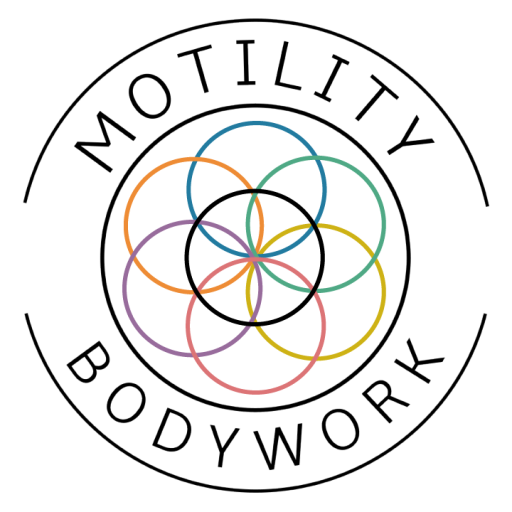Motility Bodywork
About Us
ABOUT MOTILITY BODYWORK: OUR JOURNEY TO HOLISTIC BODYWORK THERAPY
In 2002, a good friend began training as an Osteopath in Canada. His work intrigued me, especially when discussing the connection between the organs, emotions, and the body’s pain. This sparked my interest in holistic bodywork therapy, shifting my understanding of the body from a “biological machine” of isolated parts to an interconnected system.

Back to that Canadian Osteopath. My wife wanted to see him again. However, he was in Buffalo, NY, and we were in Tulsa, OK. Traveling was an option but not so practical. So she asked if he knew anyone who did this work in/near Tulsa. That’s when we met Leigh Ankrum. She had attended the same training and was practicing here in Tulsa. My wife went to visit Leigh and was quite happy with the work. I saw the practical results of the work and was particularly intrigued by the freedom of her practice. Within a few boundaries, the client and Leigh could pursue health as seemed best. They were not restrained by bureaucracy and insurance companies. I liked that.
That conversation changed everything. After years of thinking, “That’s not practical for me,” the opportunity to change the course of my career had not just presented itself, but it had virtually slapped me in the face. Instead of thinking, “That’s not practical,” I was struck that this time, it was practical, and the opportunity was looking me right in the face. So, we canceled our plans, turned the car around, and headed back to Tulsa for that introductory session. That session confirmed what I knew: I had to attend the Ankrum Institute.
Our Focus at Motility Bodywork
- Prenatal care. Here, we focus on the balance and mobility of the woman’s body. In particular, we are looking for movement in the pelvis and the upper body. When we gain this movement, we can often solve lower back pain, create more room for the baby, and allow the baby to turn, among other benefits. In short, the woman’s body is trying to make changes, and I am working to facilitate those changes. When her body can do that, she often feels much more comfortable, and her body can take better care of the baby.
C-section care. A C-section scar will often cause trouble not just at the scar site but in other parts of the body as well. Common C-section issues include low back pain, pain on the scar side, numbness, feeling “pulled forward,” bladder issues, or pain during intercourse. When the scar is released, the symptoms often improve dramatically, even after many years.
- The bladder is often restricted and too low in the pelvis for various reasons. When this happens, the control muscles can’t perform their job correctly. This can result from surgery, childbirth, a car accident, or simply a prolonged period of tension. When the tension is released and the bladder can move back into place, the results are often immediate and dramatic.
- Shoulder pain. The shoulder is a complicated joint that requires proper movement in the socket and for the shoulder blade to move along the ribs. I have helped many people avoid shoulder surgery who once thought that surgery was inevitable.
- Scar issues. Scars often play a significant role when there is pain in the body. They are like wild cards that can cause a range of problems. Some common issues I see from scars are as follows: C-section scars often cause low back pain, pelvic tightness, or pain during intercourse. Abdominal scars often cause structural issues that force the body to compensate for how it moves. Breast scars typically pull the head and shoulders forward, causing upper back pain, shoulder pain, and headaches. When looking at the body holistically, scars are some of the most critical factors.
- Neck pain. Neck pain can stem from several issues, including surgery, whiplash, or poor posture, such as prolonged sitting at a desk. When considering neck pain, it is essential to factor in the shoulders’ role. It is also important to consider how the heart and lungs might be contributing. If there’s previous tension in the heart (due to a car accident, for example), that tension will often transfer into the neck and pull the head forward. Like all body parts, the most important factors with neck pain involve positioning and mobility.
After I graduated from the Ankrum Institute, I opened my osteopathic practice, but my education didn’t stop there. My initial training gave me a solid foundation but was not the end. Since then, I have attended the following specialized trainings:
Barral Institute – Focused on visceral manipulation (working with organs) to restore mobility and balance.
MNRI – Focused on body proprioception and the integration of primary reflexes for better movement and function.
DNS – Focused on infant development positions and how they can be translated into adult recovery and rehabilitation.
Center for Pain Management – Focused on orthopedic massage to address musculoskeletal pain and discomfort.
Chikly Institute – Focused on lymphatic work and how it interacts with the brain to support overall health.
Coaching the Body – Focused on orthopedic massage techniques for relieving muscular tension.
Body Ready Method – Focused on prenatal movements and positioning to support pregnancy wellness.
Eric Dalton – Various techniques to release tension and improve mobility in the body.
Tom Myers – Focused on how the muscles and tissues flow together, impact one another, and their role in female health and
